ISUZU KB P190 2007 Workshop Repair Manual
Manufacturer: ISUZU, Model Year: 2007, Model line: KB P190, Model: ISUZU KB P190 2007Pages: 6020, PDF Size: 70.23 MB
Page 121 of 6020

HEATER AND AIR CONDITIONING 1-87
BLOWER MOTOR DOES NOT RUN IN CERTAIN POSITION
A 1: (Low)
Blower motor does not
B 2: (Medium Low) Position
run at
C 3: (Medium Hi)
D 4: (High)
* Checkin
g is performed only when in the malfunction
mode.
•
Is resistor OK?
YES
•
Is fan control knob (Fan switch) OK?
YES
Condition:
•
O
pen circuit between chassis side connector
terminal No. C104-2 and No. B13-3
B Condition :
•
O
pen circuit between chassis side connector
terminal No. C104-4 and No. B13-6
C Condition:
•
O
pen circuit between chassis side connector
terminal No. C104-1 and No. B13-5
D Condition:
•
O
pen circuit between chassis side connector
terminal No. C105-2 and No. B13-4
Replace
NO
NO
Replace control leverassembly A
BACK TO CHAPTER INDEX
TO MODEL INDEX
ISUZU KB P190 2007
Page 122 of 6020

1-88 HEATER AND AIR CONDITIONING
BLOWER MOTOR DOES NOT STOP AT “OFF” POSITION
•
Is fan control knob (Fan switch)OK?
YES
Check the circuit between chassis side connector terminals
for short to GND
•
No.
C105-2 and No. C104-3
(or)
•
No
. C105-2 and No. B13-4
(or)
•
No
. C104-1 and No. B13-5
(or)
•
No
. C104-4 and No. B13-6
(or)
•
No
. C104-2 and No. B13-3
NO
Replace control lever assembly
BACK TO CHAPTER INDEX
TO MODEL INDEX
ISUZU KB P190 2007
Page 123 of 6020
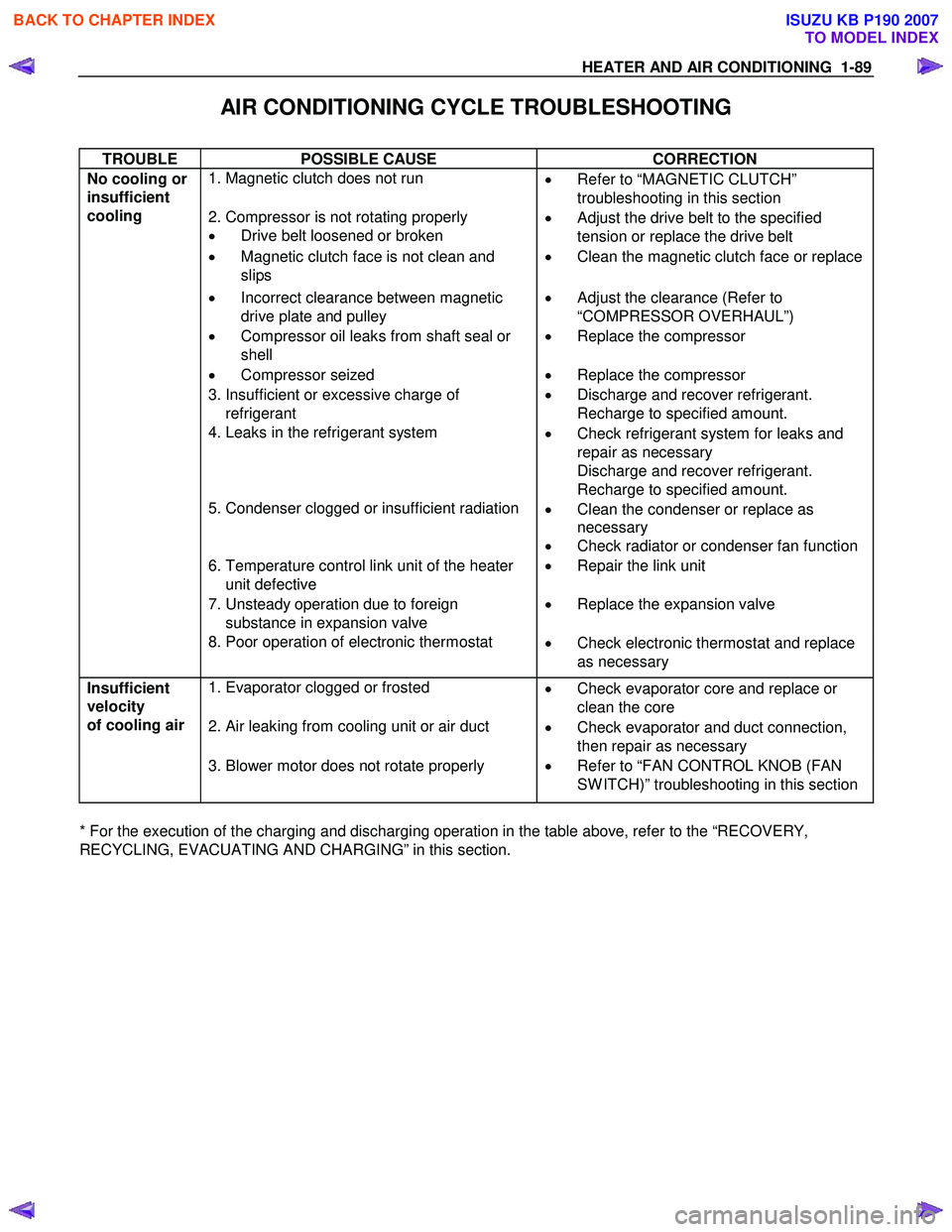
HEATER AND AIR CONDITIONING 1-89
AIR CONDITIONING CYCLE TROUBLESHOOTING
TROUBLE POSSIBLE CAUSE CORRECTION
1. Magnetic clutch does not run
•
Refer to “MAGNETIC CLUTCH”
troubleshooting in this section
2. Compressor is not rotating properly
• Drive belt loosened or broken •
Adjust the drive belt to the specified
tension or replace the drive belt
• Magnetic clutch face is not clean and
slips •
Clean the magnetic clutch face or replace
• Incorrect clearance between magnetic
drive plate and pulley •
Adjust the clearance (Refer to
“COMPRESSOR OVERHAUL”)
• Compressor oil leaks from shaft seal or
shell •
Replace the compressor
• Compressor seized • Replace the compressor
3. Insufficient or excessive charge of
refrigerant •
Discharge and recover refrigerant.
Recharge to specified amount.
4. Leaks in the refrigerant system
•
Check refrigerant system for leaks and
repair as necessary
Discharge and recover refrigerant.
Recharge to specified amount.
5. Condenser clogged or insufficient radiation
•
Clean the condenser or replace as
necessary
• Check radiator or condenser fan function
6. Temperature control link unit of the heater
unit defective •
Repair the link unit
7. Unsteady operation due to foreign
substance in expansion valve •
Replace the expansion valve
No cooling or
insufficient
cooling
8. Poor operation of electronic thermostat
•
Check electronic thermostat and replace
as necessary
1. Evaporator clogged or frosted
•
Check evaporator core and replace or
clean the core
2. Air leaking from cooling unit or air duct
•
Check evaporator and duct connection,
then repair as necessary
Insufficient
velocity
of cooling air
3. Blower motor does not rotate properly
• Refer to “FAN CONTROL KNOB (FAN
SW ITCH)” troubleshooting in this section
* For the execution of the charging and discharging operation in the table above, refer to the “RECOVERY,
RECYCLING, EVACUATING AND CHARGING” in this section.
BACK TO CHAPTER INDEX
TO MODEL INDEX
ISUZU KB P190 2007
Page 124 of 6020
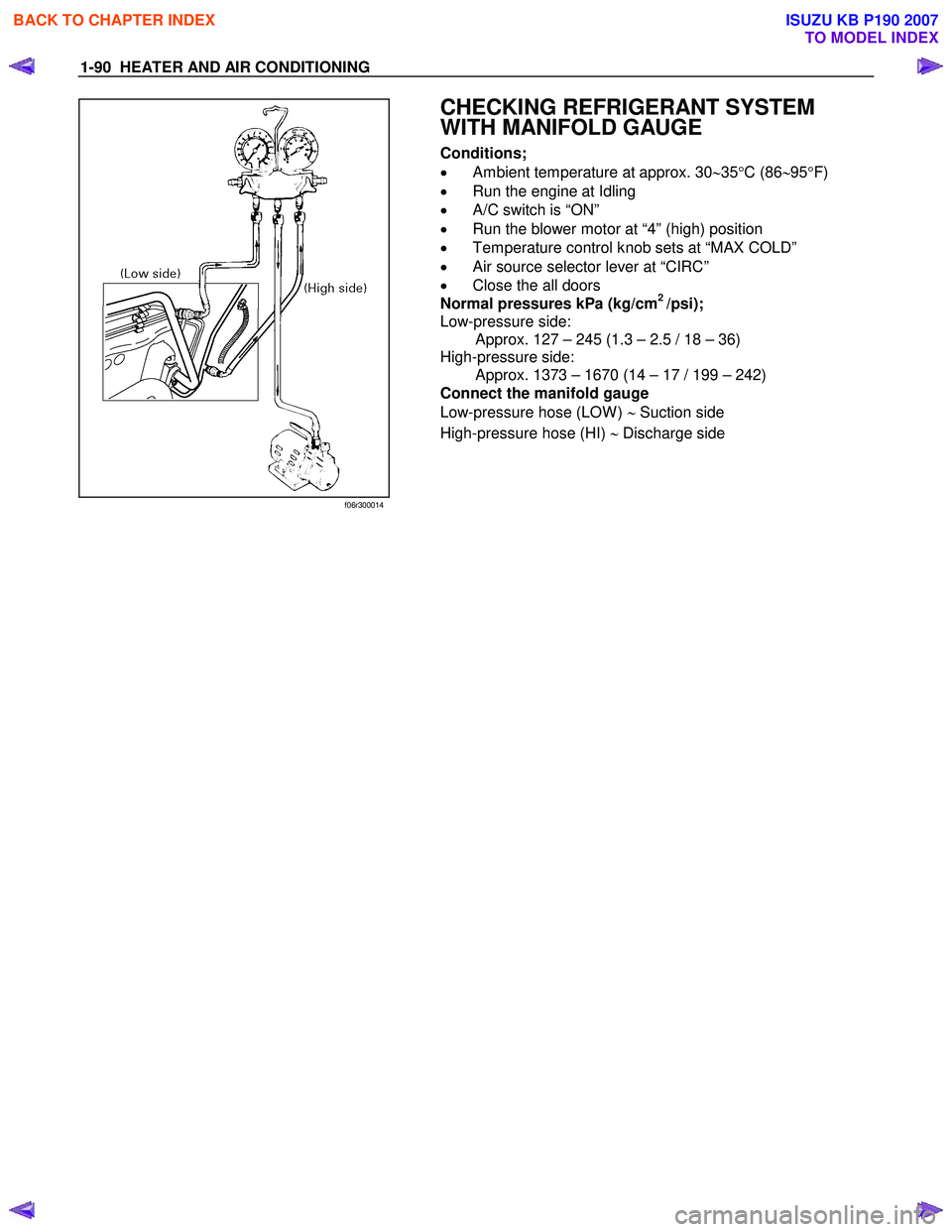
1-90 HEATER AND AIR CONDITIONING
f06r300014
CHECKING REFRIGERANT SYSTEM
WITH MANIFOLD GAUGE
Conditions;
• Ambient temperature at approx. 30 ∼35 °C (86 ∼95 °F)
• Run the engine at Idling
• A/C switch is “ON”
• Run the blower motor at “4” (high) position
• Temperature control knob sets at “MAX COLD”
• Air source selector lever at “CIRC”
• Close the all doors
Normal pressures kPa (kg/cm
2 /psi);
Low-pressure side: Approx. 127 – 245 (1.3 – 2.5 / 18 – 36)
High-pressure side: Approx. 1373 – 1670 (14 – 17 / 199 – 242)
Connect the manifold gauge
Low-pressure hose (LOW ) ∼ Suction side
High-pressure hose (HI) ∼ Discharge side
BACK TO CHAPTER INDEX
TO MODEL INDEX
ISUZU KB P190 2007
Page 125 of 6020
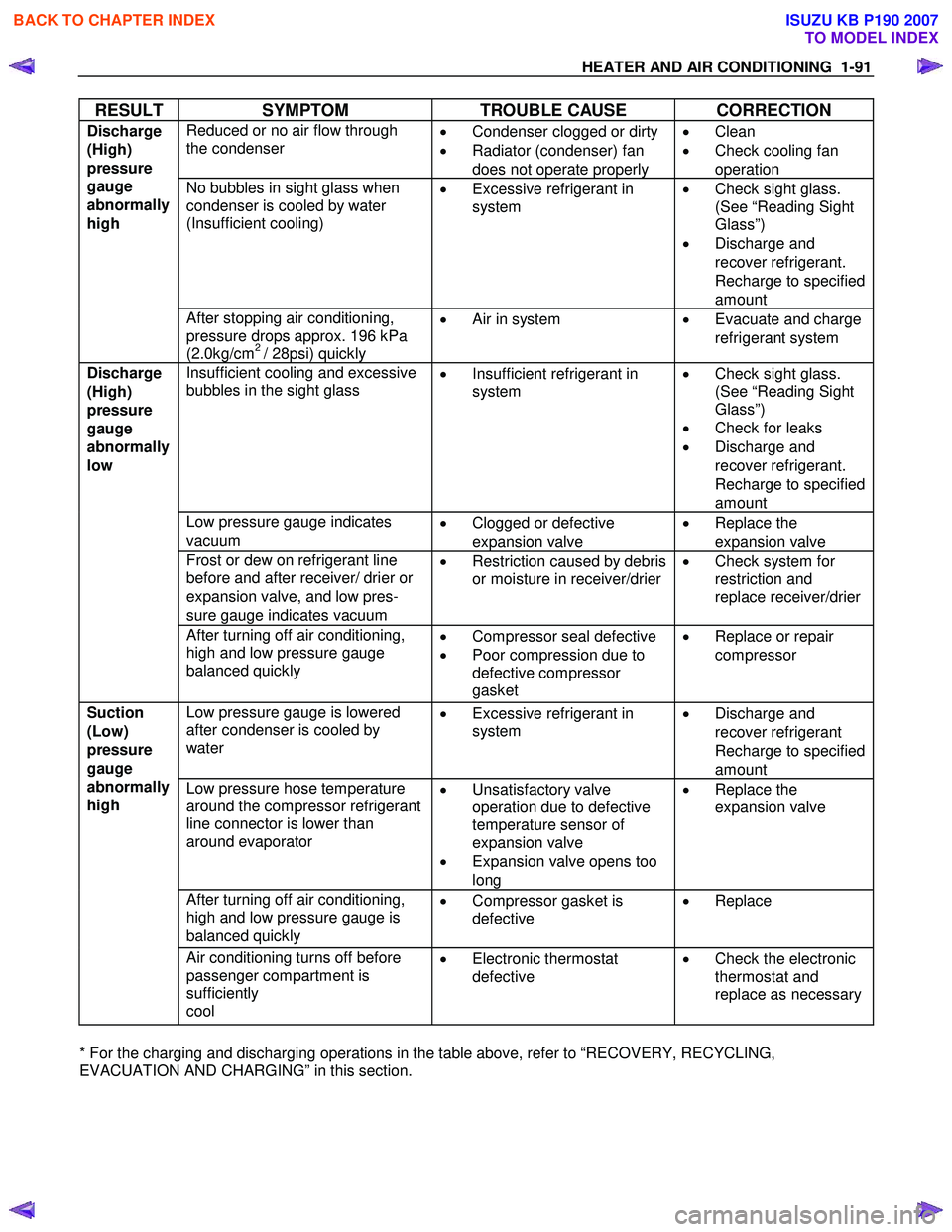
HEATER AND AIR CONDITIONING 1-91
RESULT SYMPTOM TROUBLE CAUSE CORRECTION
Reduced or no air flow through
the condenser
•
Condenser clogged or dirty
• Radiator (condenser) fan
does not operate properly •
Clean
• Check cooling fan
operation
No bubbles in sight glass when
condenser is cooled by water
(Insufficient cooling)
•
Excessive refrigerant in
system
•
Check sight glass.
(See “Reading Sight
Glass”)
• Discharge and
recover refrigerant.
Recharge to specified
amount
Discharge
(High)
pressure
gauge
abnormally
high
After stopping air conditioning,
pressure drops approx. 196 kPa
(2.0kg/cm
2 / 28psi) quickly •
Air in system
•
Evacuate and charge
refrigerant system
Insufficient cooling and excessive
bubbles in the sight glass
•
Insufficient refrigerant in
system
•
Check sight glass.
(See “Reading Sight
Glass”)
• Check for leaks
• Discharge and
recover refrigerant.
Recharge to specified
amount
Low pressure gauge indicates
vacuum •
Clogged or defective
expansion valve •
Replace the
expansion valve
Frost or dew on refrigerant line
before and after receiver/ drier or
expansion valve, and low pres-
sure gauge indicates vacuum •
Restriction caused by debris
or moisture in receiver/drier
•
Check system for
restriction and
replace receiver/drier
Discharge
(High)
pressure
gauge
abnormally
low
After turning off air conditioning,
high and low pressure gauge
balanced quickly
•
Compressor seal defective
• Poor compression due to
defective compressor
gasket •
Replace or repair
compressor
Low pressure gauge is lowered
after condenser is cooled by
water
•
Excessive refrigerant in
system
•
Discharge and
recover refrigerant
Recharge to specified
amount
Low pressure hose temperature
around the compressor refrigerant
line connector is lower than
around evaporator
•
Unsatisfactory valve
operation due to defective
temperature sensor of
expansion valve
• Expansion valve opens too
long •
Replace the
expansion valve
After turning off air conditioning,
high and low pressure gauge is
balanced quickly •
Compressor gasket is
defective
•
Replace
Suction
(Low)
pressure
gauge
abnormally
high
Air conditioning turns off before
passenger compartment is
sufficiently
cool •
Electronic thermostat
defective
•
Check the electronic
thermostat and
replace as necessary
* For the charging and discharging operations in the table above, refer to “RECOVERY, RECYCLING,
EVACUATION AND CHARGING” in this section.
BACK TO CHAPTER INDEX
TO MODEL INDEX
ISUZU KB P190 2007
Page 126 of 6020
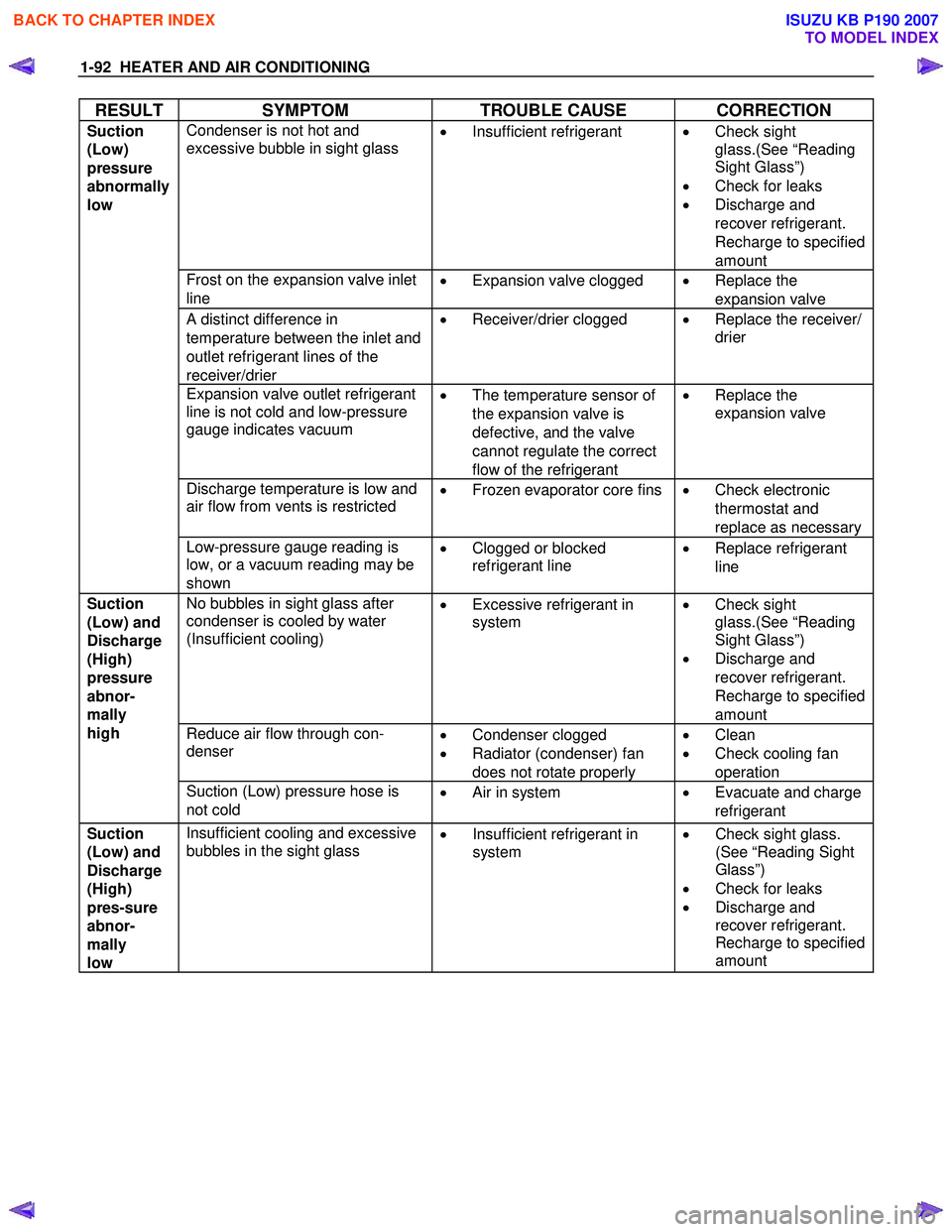
1-92 HEATER AND AIR CONDITIONING
RESULT SYMPTOM TROUBLE CAUSE CORRECTION
Condenser is not hot and
excessive bubble in sight glass
•
Insufficient refrigerant
•
Check sight
glass.(See “Reading
Sight Glass”)
• Check for leaks
• Discharge and
recover refrigerant.
Recharge to specified
amount
Frost on the expansion valve inlet
line •
Expansion valve clogged
•
Replace the
expansion valve
A distinct difference in
temperature between the inlet and
outlet refrigerant lines of the
receiver/drier •
Receiver/drier clogged
•
Replace the receiver/
drier
Expansion valve outlet refrigerant
line is not cold and low-pressure
gauge indicates vacuum
•
The temperature sensor of
the expansion valve is
defective, and the valve
cannot regulate the correct
flow of the refrigerant •
Replace the
expansion valve
Discharge temperature is low and
air flow from vents is restricted
•
Frozen evaporator core fins
•
Check electronic
thermostat and
replace as necessary
Suction
(Low)
pressure
abnormally
low
Low-pressure gauge reading is
low, or a vacuum reading may be
shown •
Clogged or blocked
refrigerant line
•
Replace refrigerant
line
No bubbles in sight glass after
condenser is cooled by water
(Insufficient cooling)
•
Excessive refrigerant in
system
•
Check sight
glass.(See “Reading
Sight Glass”)
• Discharge and
recover refrigerant.
Recharge to specified
amount
Reduce air flow through con-
denser
•
Condenser clogged
• Radiator (condenser) fan
does not rotate properly •
Clean
• Check cooling fan
operation
Suction
(Low) and
Discharge
(High)
pressure
abnor-
mally
high
Suction (Low) pressure hose is
not cold •
Air in system • Evacuate and charge
refrigerant
Suction
(Low) and
Discharge
(High)
pres-sure
abnor-
mally
low Insufficient cooling and excessive
bubbles in the sight glass •
Insufficient refrigerant in
system
•
Check sight glass.
(See “Reading Sight
Glass”)
• Check for leaks
• Discharge and
recover refrigerant.
Recharge to specified
amount
BACK TO CHAPTER INDEX
TO MODEL INDEX
ISUZU KB P190 2007
Page 127 of 6020
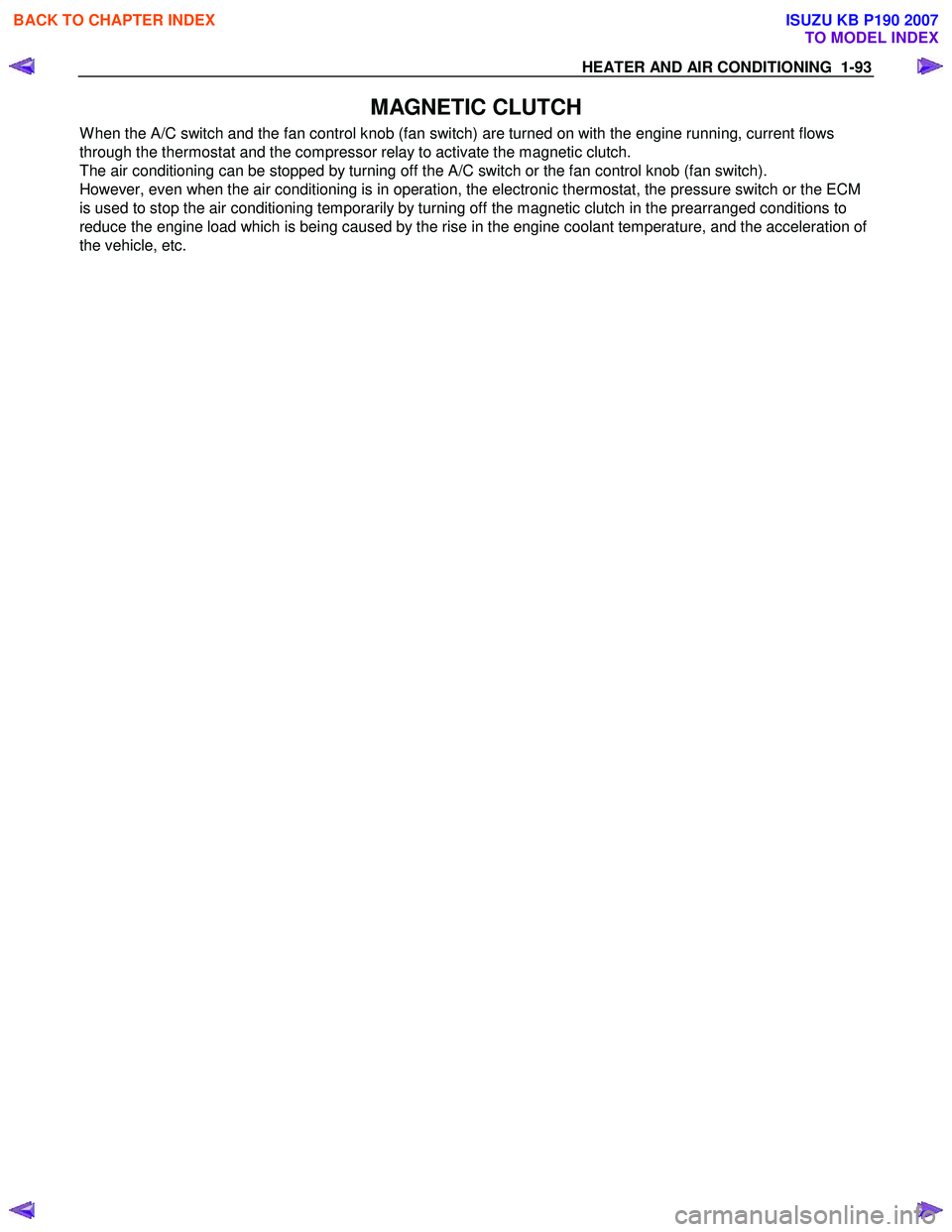
HEATER AND AIR CONDITIONING 1-93
MAGNETIC CLUTCH
W hen the A/C switch and the fan control knob (fan switch) are turned on with the engine running, current flows
through the thermostat and the compressor relay to activate the magnetic clutch.
The air conditioning can be stopped by turning off the A/C switch or the fan control knob (fan switch).
However, even when the air conditioning is in operation, the electronic thermostat, the pressure switch or the ECM
is used to stop the air conditioning temporarily by turning off the magnetic clutch in the prearranged conditions to
reduce the engine load which is being caused by the rise in the engine coolant temperature, and the acceleration of
the vehicle, etc.
BACK TO CHAPTER INDEX
TO MODEL INDEX
ISUZU KB P190 2007
Page 128 of 6020

1-94 HEATER AND AIR CONDITIONING
4JA1 – T
RTW 710XF000201
BACK TO CHAPTER INDEX
TO MODEL INDEX
ISUZU KB P190 2007
Page 129 of 6020
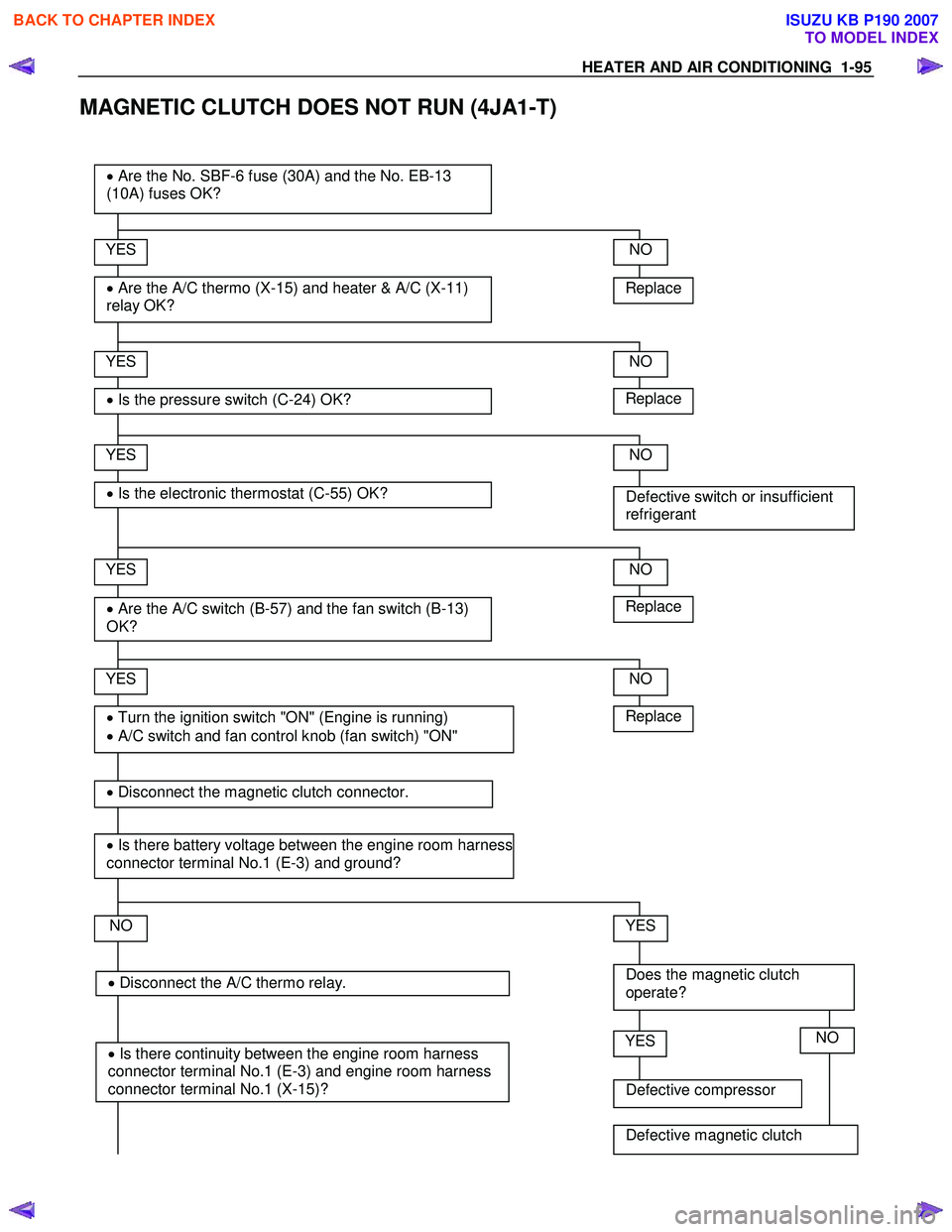
HEATER AND AIR CONDITIONING 1-95
MAGNETIC CLUTCH DOES NOT RUN (4JA1-T)
Replace
YES
• Are the A/C thermo (X-15) and heater & A/C (X-11)
relay OK?
• Are the No. SBF-6 fuse (30A) and the No. EB-13
(10A) fuses OK?
YES
• Is the pressure switch (C-24) OK?
YES
• Are the A/C switch (B-57) and the fan switch (B-13)
OK?
NO
YES
• Turn the ignition switch "ON" (Engine is running)
• A/C switch and fan control knob (fan switch) "ON"
NO
Replace
NO
Defective switch or insufficient
refrigerant
NO
NO
Does the magnetic clutch
operate?
YES
Replace
• Disconnect the magnetic clutch connector.
• Is there battery voltage between the engine room harness
connector terminal No.1 (E-3) and ground?
Defective compressor
YESNO
Defective magnetic clutch
• Is the electronic thermostat (C-55) OK?
YES
Replace
NO
• Disconnect the A/C thermo relay.
• Is there continuity between the engine room harness
connector terminal No.1 (E-3) and engine room harness
connector terminal No.1 (X-15)?
BACK TO CHAPTER INDEX
TO MODEL INDEX
ISUZU KB P190 2007
Page 130 of 6020
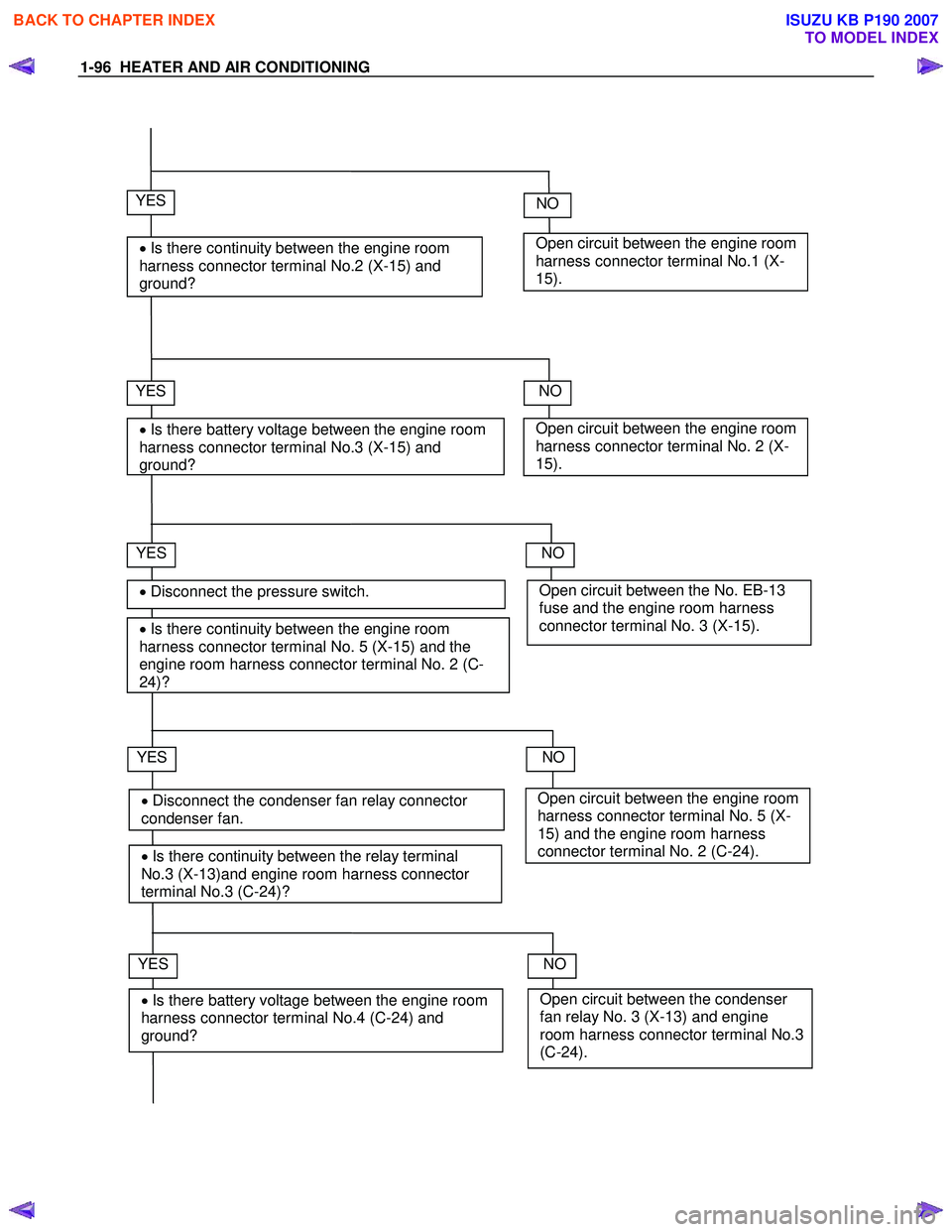
1-96 HEATER AND AIR CONDITIONING
Open circuit between the engine room
harness connector terminal No.1 (X-
15).
NOYES
• Is there continuity between the engine room
harness connector terminal No.2 (X-15) and
ground?
YES
• Is there battery voltage between the engine room
harness connector terminal No.3 (X-15) and
ground? Open circuit between the engine room
harness connector terminal No. 2 (X-
15).
NO
YES
• Is there continuity between the engine room
harness connector terminal No. 5 (X-15) and the
engine room harness connector terminal No. 2 (C-
24)?
Open circuit between the No. EB-13
fuse and the engine room harness
connector terminal No. 3 (X-15).
NO
• Disconnect the pressure switch.
• Disconnect the condenser fan relay connector
condenser fan.
• Is there battery voltage between the engine room
harness connector terminal No.4 (C-24) and
ground? Open circuit between the condenser
fan relay No. 3 (X-13) and engine
room harness connector terminal No.3
(C-24).
• Is there continuity between the relay terminal
No.3 (X-13)and engine room harness connector
terminal No.3 (C-24)?
Open circuit between the engine room
harness connector terminal No. 5 (X-
15) and the engine room harness
connector terminal No. 2 (C-24).
YES NO
YES NO
BACK TO CHAPTER INDEX
TO MODEL INDEX
ISUZU KB P190 2007